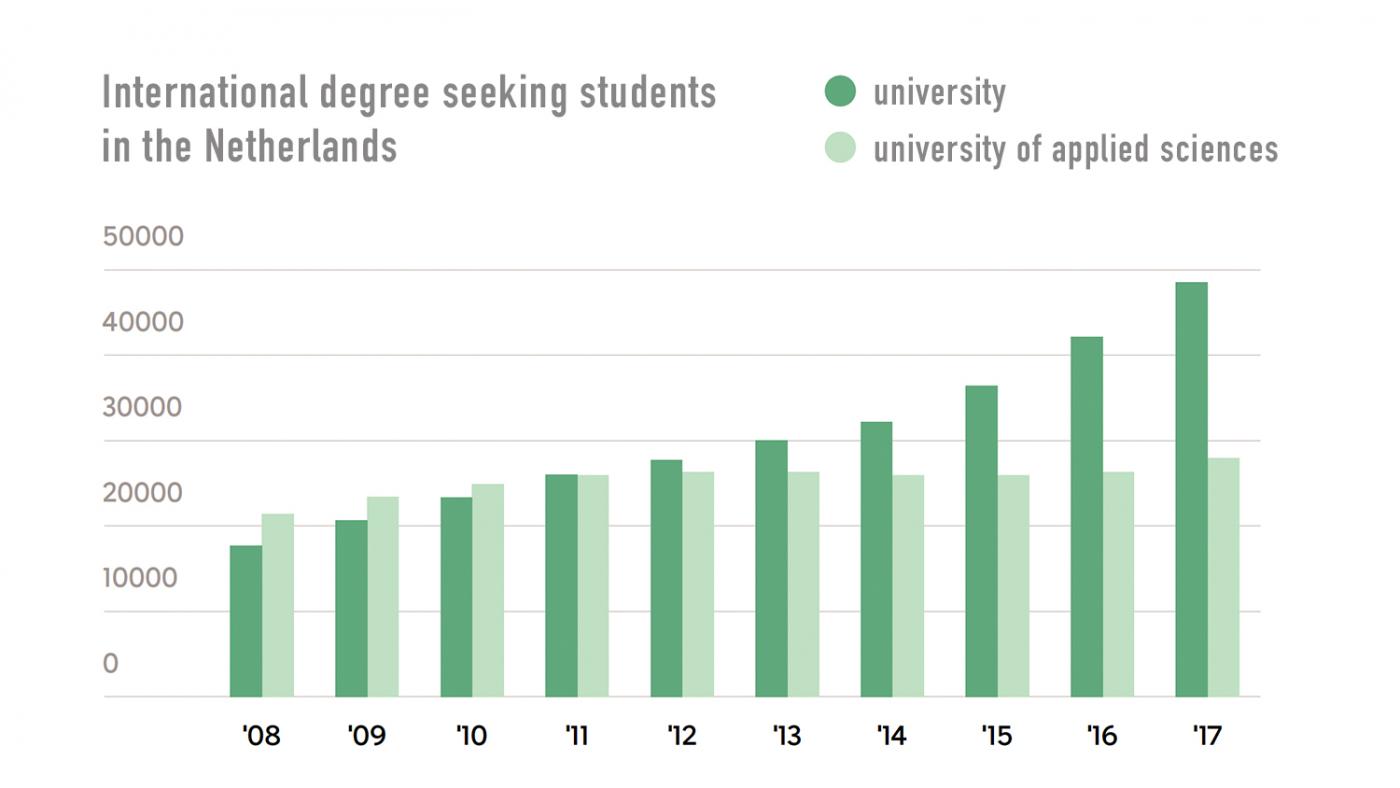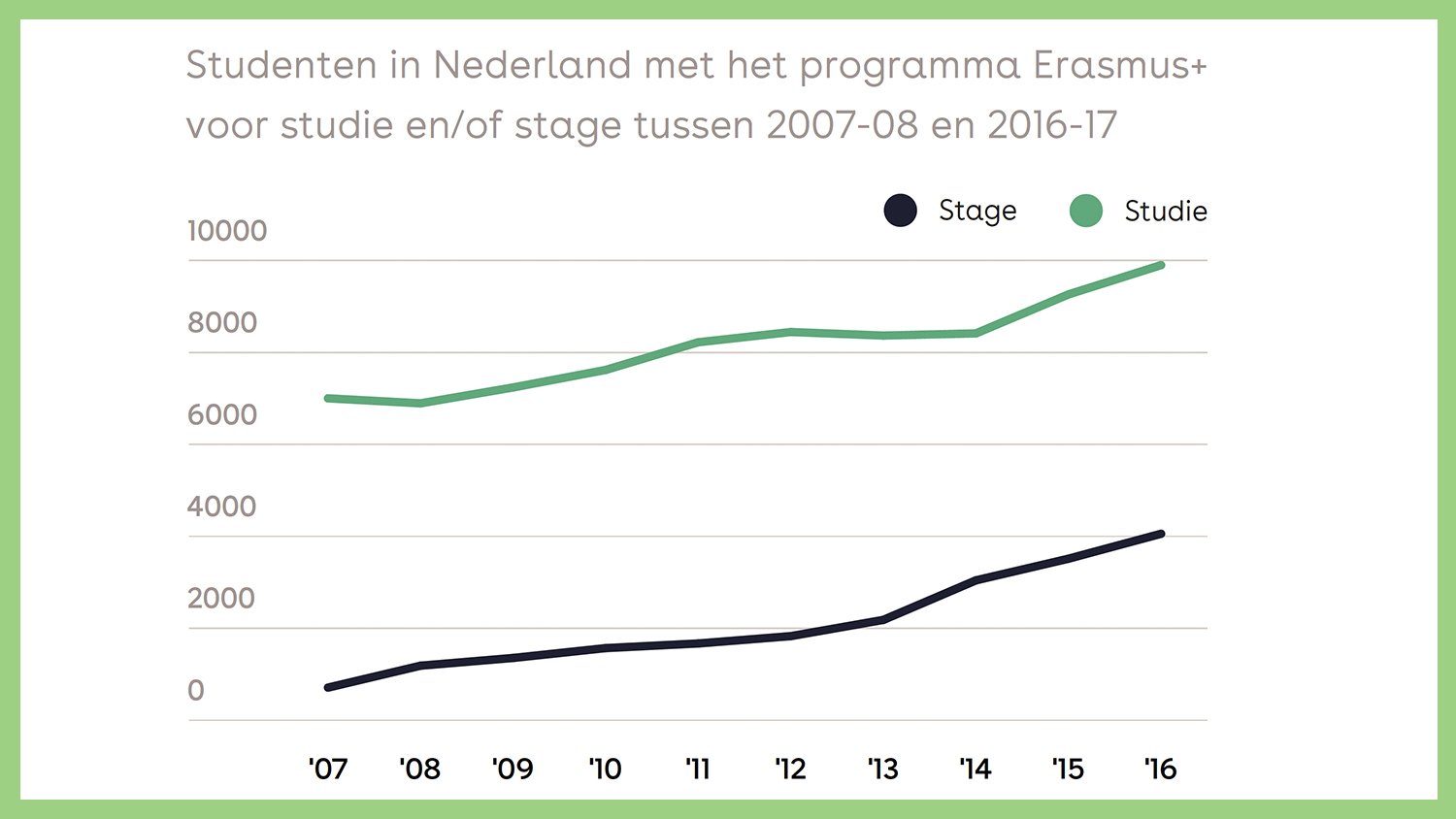Increasingly more international students in Dutch lecture halls

In higher education, 10.5 percent of students now come from abroad. Most of them study at a university. In the past, the majority opted for a university of applied sciences, however since 2011 the roles have been reversed. This is mainly due to the increasing popularity of master's programs at universities: currently, one in five students is an international. This you can read in a monitor from internationalization organization Nuffic, which was presented last week.
This tendency is also recognizable at Utrecht University, is indicated by data of the university itself. The percentage of international students was 10.2 percent in 2018 ( compared to 7.7 percent in 2015).
From figures presented in a survey of the Taskfoce Internationalisation in November 2018, it becomes clear that Utrecht welcomed a smaller percentage international bachelor student (5 percent in 2017 ) than master students (20 percent in 2017). "Utrecht University needs to do more to become a truly international university. But all efforts are in vain if the housing problem for international students and staff is not addressed," was the conclusion from the Taskforce in an article DUB wrote earlier.
Germans and Chinese
Germans in particular (22,125) find their way to the Dutch lecture halls, followed by Chinese (4,475) and Italians (4,077). It is notable that in the last five years increasingly more Indians, Italians and Spaniards want to get a diploma here.
They most often opt for an economics study at a university or university of applied sciences. Furthermore, art colleges in higher professional education have traditionally attracted many internationals: more than a third come from abroad. At the universities, social and technical studies are particularly popular.
Almost a quarter of the internationals who have graduated from a Dutch university or university of applied sciences still live in our country after five years. This provides between 1.64 and 2.08 billion euros annually, according to a Nuffic report published last year.
Exchange students
The Netherlands is also becoming increasingly popular among students with an Erasmus scholarship. Nearly 10,000 internationals came to the Netherlands for one or two semesters in 2016 via an exchange program at a university or a university of applied sciences. Another 4,000 students were doing an internship here. For comparison, in 2007 there were 7,000 and less than 1,000 respectively.
Students in the Netherlands with the Erasmus + program for study and / or internships between 2007-08 and 2016-17: Internship (black) ; Study (green)

Dutch ga abroad
Many Dutch students also go abroad for an internship or exchange program. A quarter of all graduates in higher education travelled across the border for their studies. With this, the Netherlands scores well above the European standard of 20 percent for 2020.
The UU lags behind compared to other Dutch universities. The Taskforce Internationalisation reported in November a number of 18 percent of the bachelor students with experience abroad, and 8 percent of the master students.
The Norwegians are at the top of the list: 35 percent of them went for an exchange, internship or research abroad.
Dutch students with a foreign experience (%) compared to other EU countries
- Different kind of foreign experience
- Study & internship combined
- Internship
- Study Exchange
- Benchmark EU 2020 (dotted line)

Packing suitcases
Especially for higher professional education and university students in 'green' study programmes, going abroad is appealing. Many university master's students in engineering and sciences also pack their suitcases, usually for an internship. Finally, medical students often cross the border for, for example, medical internships.
Dutch students are most likely to study at prestigious British institutions such as Oxford, Cambridge and King's College London. Belgium is also popular, especially among students of medicine or obstetrics, who are dealing with a numerus fixus here.
The number of Dutch students who make use of their student finance during their stay has declined after years of growth in 2016. According to Nuffic, this has to do with the introduction of the loan system. The effect this is going to have on the number of students graduating abroad is examined by Nuffic.
Dutch diploma students abroad. Total and those using their student finance between 06-07 and 16-17
- Dutch diploma students abroad
- Dutch diploma students abroad with student finance

“This applies less to students who go abroad for a semester, because that is often part of the curriculum. But if it is an extra-curricular activity and there is a chance of study delay, then students will have to think twice about it”, says Nuffic spokesperson Anne Lutgerink expects.
Challenge
According to Nuffic, despite the growing interest in internationalization in higher education, there is still a lot to be gained. For example, only 13 percent of students from university teacher training have relevant foreign experience. That percentage is even lower for higher professional education teachers: 6 percent. Teachers play an important role in developing students' international skills. Because classes in the Netherlands are becoming increasingly diverse, there is still a big challenge, according to Nuffic.
It is also mainly students with highly educated parents who gain experience abroad. They follow an exchange program more than one and a half times more often than students without highly educated parents. “That is cause for concern. You want everyone to have that possibility, regardless of their background”, says Lutgerink. Grants for that specific target group may change that.